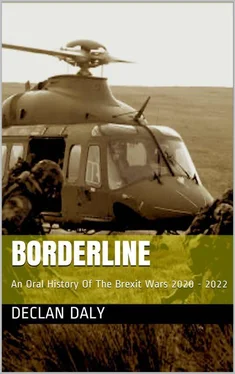The first task we receive from the NACC dispatcher is a good ‘first job’ for the newer guys. It’s a pick-up of a patient with a suspected STEMI in Tobercurry, North of Knock Airport. The weather is a stable cloud base at 600 – 700 feet with 10+ vis underneath. There’s enough involved that the newer guys will have to do a bit of thinking about our route, but no real pressure on the rest of us so we can help the learning process along as much as possible. Everything goes fine on the outbound leg, the weather stays unusually ‘the same’ and even with the pick-up site on rising ground, the cloud doesn’t touch the ground until about a mile North of our target.
It stays this way until we land on at Galway Hospital. I notice a flurry of activity in the back and Pat calls ‘Cab off’ – he wants to isolate the comms in the back from the cockpit. I look over my shoulder and see Luke starting chest compressions on the previously stable patient who has gone into cardiac arrest just as we touched down. As this is Paul’s first real job, I decide to keep this to myself and we run through the shutdown checks as normal in the cockpit – you never know how people will react the first time this happens around them and it’s usually quickest and safest to just get things done like you always would. By the time the engines wind down enough to hear what’s happening in the back, the patient is alive again and moaning at Luke to stop hurting her chest. This is all normal; the lads take it perfectly in their stride. A fairly standard ‘Welcome to EAS’.
Since 1963, the Irish Air Corps has provided an unbroken service to the state in terms of moving the sick and injured around the country by helicopter. Starting with the Alouette III, the Air Corps introduced an air ambulance service moving patients in need of specialist care from regional hospitals to major ones where definitive care was available. The Air Corps also introduced Ireland’s first Search and Rescue (SAR) capability, but although there’s an overlap in the end result to the patient, this is a very different service. Through the years, various different aircraft have been used to move patients between hospitals, with the advent of the Dauphin helicopter allowing a comparatively limited night time capability. These were all however hospital to hospital or hospital to airport missions, today they would be described as an IHT (Inter Hospital Transfer) or Tertiary HEMS. This means that patients were not being moved from the scene of an incident to hospital. In 2011, the Air Corps began a pilot project in concert with the National Ambulance Service to assess the need for a national HEMS. Initially envisaged as a one-year assessment, this mission began flying in 2012 and became what we today call the Emergency Aeromedical Service. Despite responding to thousands of calls in the intervening years, not much is publicly advertised about how we go about our business or what is involved for a crewmember who wants to fly a HEMS mission in Ireland. Having been fortunate enough to be involved from the very beginning of the service, this is my own experience of flying HEMS in Ireland.
Medevac: Flying The Irish Air Corps HEMS Mission is availble on Amazon
(Non Fiction)
Medevac: Flying The Irish Air Corps HEMS Mission
Copyright © 2020 Declan Daly
All rights reserved
The characters and events portrayed in this book are fictitious. Any similarity to real persons, living or dead, is coincidental and not intended by the author.
No part of this book may be reproduced, or stored in a retrieval system, or transmitted in any form or by any means, electronic, mechanical, photocopying, recording, or otherwise, without express written permission of the publisher.
ISBN-13: 9781234567890
ISBN-10: 1477123456
Cover design by: Art Painter
Library of Congress Control Number: 2018675309
Printed in the United States of America












